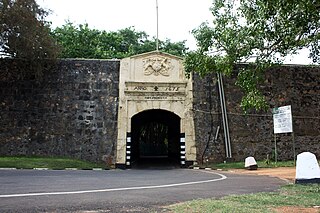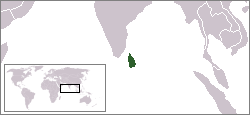
Point Pedro, also known as Paruthithurai is a town, located in Jaffna District, Sri Lanka, at the northernmost point of the island.
Elephant Pass is located at the gateway of the Jaffna Peninsula in Northern Province, Sri Lanka. It lies about 340 km north of the capital. It has an important military base and used to be the island's largest salt field. It was regularly the site of battles during the Sri Lankan Civil War.

Fort Fredrick, also known as Trincomalee Fort or Fort of Triquillimale, is a fort built by the Portuguese at Trincomalee, Eastern Province, Sri Lanka, completed in 1624 CE, built on Swami Rock-Konamamalai from the debris of the world-famous ancient Hindu Koneswaram temple. The temple was destroyed by the Portuguese colonial Constantino de Sá de Noronha under Phillip III, occupier of the Jaffna kingdom and Malabar country on the island. On the Konamalai cape was also built a new village of Portuguese and Tamil people, 50 Portuguese soldiers and inside the fort, a church named after "Nossa Senhora de Guadalupe". The Fort of Triquillimale was dismantled and rebuilt by the Dutch in 1665, renamed Fort Fredrick.
Karaiyar is a Sri Lankan Tamil caste found mainly on the northern and eastern coastal areas of Sri Lanka, and globally among the Tamil diaspora.

Eelam War II is the name given to the second phase of armed conflict between Sri Lankan military and the separatist Liberation Tigers of Tamil Eelam. The war started after the failure of peace talks between the Premadasa government and the LTTE. This phase of the war was initiated by the LTTE who massacred almost 600 Sinhalese and Muslim police personnel after they were ordered by the Premadasa government to surrender to the LTTE. The truce was broken on June 10, 1990, when the LTTE in October expelled all the 28,000 Muslims residing in Jaffna.
Eelam War III is the name given to the third phase of armed conflict between the Sri Lankan military and the separatist Liberation Tigers of Tamil Eelam (LTTE).
Operation Liberation also known as the Vadamarachchi Operation was the military offensive carried out by the Sri Lankan Armed Forces in May and June 1987 to recapture the territory of Vadamarachchi in the Jaffna peninsula from the LTTE. At the time it was the largest combined services operation undertaken by the armed forces deploying multiple brigade-size formation, becoming the first conventional warfare engagement on Sri Lankan soil after the end of British colonial rule. The operation involved nearly 4,000 troops, supported by ground-attack aircraft, helicopter gunships and naval gun boats. The offensive achieved its primary objective, however operations were suspended when the Indian government dropped food supplies over Jaffna in Operation Poomalai on June 4, 1987, which prompted the Sri Lankan government to accept the Indo-Sri Lankan Accord.
The Battle of Mullaitivu, also known as the First Battle of Mullaitivu and codenamed Operation Unceasing Waves-1, was a battle between the militant Liberation Tigers of Tamil Eelam and the Sri Lankan military during the Sri Lankan Civil War for control of the military base in Mullaitivu in north-eastern Sri Lanka.
The Second Battle of Elephant Pass, was fought in April 2000 for the control of the Sri Lankan military base in Elephant Pass, Jaffna.
The Battle of Pooneryn took place between the militant Liberation Tigers of Tamil Eelam and the Sri Lankan military during the Sri Lankan Civil War for control of the military base in Pooneryn in northern Sri Lanka from 11 November to 14 November 1993.
Forts in Sri Lanka date back thousands of years, with many being built by Sri Lankan kings. These include several walled cities. With the outset of colonial rule in the Indian Ocean, Sri Lanka was occupied by several major colonial empires that from time to time became the dominant power in the Indian Ocean. The colonists built several western-style forts, mostly in and around the coast of the island. The first to build colonial forts in Sri Lanka were the Portuguese; these forts were captured and later expanded by the Dutch. The British occupied these Dutch forts during the Napoleonic wars.

Kopay is a Sri Lankan town about 4 km from the city of Jaffna along Point Pedro road. An agricultural town consisting mainly of vegetable farms, paddy fields and coconut gardens. The suburb Kopay has several scholars because of very strong schooling system. Arumuka Navalar established the school managed by Suwaminathan is famous for this. Arrival of Church Missionary Society (CMS) strengthened the educational system. Kopay Christian College is one of the oldest schools in Jaffna with 150 years of service remain unbeaten in producing quality scholars.

The Jaffna hospital massacre occurred on October 21 and 22, 1987, during the Sri Lankan Civil War, when troops of the Indian Peace Keeping Force entered the premises of the Jaffna Teaching Hospital in Jaffna, Sri Lanka, an island nation in South Asia, and killed between 60 and 70 patients and staff. The rebel Liberation Tigers of Tamil Eelam, the government of Sri Lanka, and independent observers such as the University Teachers for Human Rights and others have called it a massacre of civilians.
Poonakary or Pooneryn, is a strategically important village situated on the Jaffna Lagoon, directly across from the Jaffna Peninsula in the Northern Province of Sri Lanka.
Operation Thrividha Balaya was a combined military operation, the first of its kind, launched by the Sri Lankan Military in Jaffna. The Operation was carried out to break the siege of the Sri Lanka Army garrison of the old Dutch Jaffna Fort in Jaffna.
Elephant Pass Military Base is a military base located in strategic Elephant Pass, Northern Province of Sri Lanka. Elephant Pass is the gateway of the Jaffna Peninsula, which connects it to the mainland.

Mannar District is one of the 25 districts of Sri Lanka, the second level administrative division of the country. The district is administered by a District Secretariat headed by a District Secretary appointed by the central government of Sri Lanka. The capital of the district is Mannar, which is located on Mannar Island.

Jaffna is the capital city of the Northern Province of Sri Lanka. It is the administrative headquarters of the Jaffna District located on a peninsula of the same name. With a population of 88,138 in 2012, Jaffna is Sri Lanka's 12th most populous city. Jaffna is approximately ten kilometres from Kandarodai which served as an emporium in the Jaffna peninsula from classical antiquity. Jaffna's suburb Nallur served as the capital of the four-century-long medieval Tamil Jaffna Kingdom.

Pooneryn Fort is located in Pooneryn, adjacent to the Jaffna Peninsula. It was built by the Portuguese to protect their possessions in Jaffna. The fort was captured by the Dutch in 1658, and subsequently by the British in 1796.
The Battle of Mandaitivu took place during the Sri Lankan Civil War. It occurred on 28 June 1995 in which the LTTE militants attacked and overran the Sri Lanka Army detachment in the island of Mandaitivu in Jaffna.












